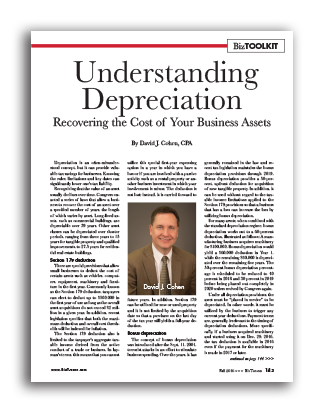
Understanding Depreciation
By David J. Cohen, CPA –
Recovering the Cost of Your Business Assets
Depreciation is an often-misunderstood concept, but it can provide valuable tax savings for businesses. Knowing the rules, limitations and key dates can significantly lower one’s tax liability.
Recognizing that the value of an asset usually declines over time, Congress enacted a series of laws that allow a business to recover the cost of an asset over a specified number of years, the length of which varies by asset. Long-lived assets, such as commercial buildings, are depreciable over 39 years. Other asset classes can be depreciated over shorter periods, ranging from three years to 15 years for tangible property and qualified improvements, to 27.5 years for residential real estate buildings.
Section 179 deduction
There are special provisions that allow small businesses to deduct the cost of certain assets such as vehicles, computers, equipment, machinery and furniture in the first year. Commonly known as the Section 179 deduction, taxpayers can elect to deduct up to $500,000 in the first year of use as long as the overall asset acquisitions do not exceed $2 million in a given year. In addition, recent legislation specifies that both the maximum deduction and overall cost thresholds will be indexed for inflation.
The Section 179 deduction also is limited to the taxpayer’s aggregate taxable income derived from the active conduct of a trade or business. In layman’s terms, this means that you cannot utilize this special first-year expensing option in a year in which you have a loss or if you are involved with a passive activity such as a rental property or another business investment in which your involvement is minor. The deduction is not lost; instead, it is carried forward to future years. In addition, Section 179 can be utilized for new or used property and it is not limited by the acquisition date so that a purchase on the last day of the tax year still yields a full-year deduction.
Bonus depreciation
The concept of bonus depreciation was introduced after the Sept. 11, 2001, terrorist attacks in an effort to stimulate business spending. Over the years, it has generally remained in the law and recent tax legislation maintains the bonus depreciation provisions through 2019. Bonus depreciation provides a 50-percent, upfront deduction for acquisition of new tangible property. In addition, it can be used without regard to the taxable income limitations applied to the Section 179 provisions so that a business that has a loss can increase the loss by utilizing bonus depreciation.
For many assets, when combined with the standard depreciation regime, bonus depreciation works out to a 60-percent deduction, illustrated as follows: A manufacturing business acquires machinery for $100,000. Bonus depreciation would yield a $60,000 deduction in Year 1, while the remaining $40,000 is depreciated over the remaining five years. The 50-percent bonus depreciation percentage is scheduled to be reduced to 40 percent in 2018 and 30 percent in 2019 before being phased out completely in 2020 unless revived by Congress again.
Under all depreciation provisions, the asset must be “placed in service” to be depreciated. In other words, it must be utilized by the business to trigger any current year deductions. Payment terms are, generally, irrelevant to the timing of depreciation deductions. More specifically, if a business acquired machinery and started using it on Dec. 29, 2016, the tax deduction is available in 2016 even if the payment for the machinery is made in 2017 or later.
Business vehicles
Autos and trucks used in business activities are subject to a complex but often favorable set of rules. For example, passenger vehicles and light-duty trucks are subject to lower annual depreciation limits regardless of their cost while large trucks and “heavy” SUVs have different and more generous depreciation deductions. Often, the tax deduction depends on the manufacturer’s gross vehicle weight rating with those weighing above 6,000 pounds garnering a certain amount, while other vehicles weighing over 14,000 pounds have a larger depreciation cap. Similar to the provisions noted above, even purchases late in the taxable year can generate a full-year’s deduction.
Vehicles used for business are often subject to abuse and are frequently targeted by the IRS, so businesses should be prepared to document the business versus personal use of all vehicles. In addition, if the business use of a vehicle is less than 50 percent, the depreciation deductions are less favorable.
Tangible property safe harbor election
Another recently enhanced benefit to businesses is the ability to deduct the cost of tangible property using a de minimis safe harbor election. Under this provision, amounts paid for a “unit of property” can be expensed in the year acquired. For most, making the election allows a business to deduct up to $2,500 for each purchase. For example, if a business purchases 30 laptop computers costing $1,500 each, or $45,000 total, the business can deduct the full $45,000 as supplies and still have the full $500,000 allowance under Section 179 as noted above. This expenditure is not reflected on the balance sheet as an asset. Rather, it is expensed in the current year. To take advantage of this special provision, the business not only needs to make the annual election on its tax return, but it must also have a written accounting policy in place that documents this treatment.
For companies whose financial statements are audited, the threshold for similar purchases is increased from $2,500 to $5,000 per item.
In addition, many businesses use different methodology for handling capital assets on their internal and external financial statements. For example, under generally accepted accounting principles (GAAP), depreciation is based on the useful life on the asset. The differences between “book” depreciation and “tax” depreciation are reflected on the tax return as a reconciling item.
The rules involving tax depreciation are complicated and evolving but recent legislation has provided tax-saving opportunities for savvy business owners. One such strategy for building owners is cost segregation studies that accelerate tax depreciation deductions.
Tax law contains numerous exceptions and nuances, so businesses should consult with qualified tax advisers regarding their specific situation to determine if these generally advantageous provisions apply to them.
David J. Cohen is a certified public accountant and president of BeachFleischman CPAs in Tucson and Phoenix.




